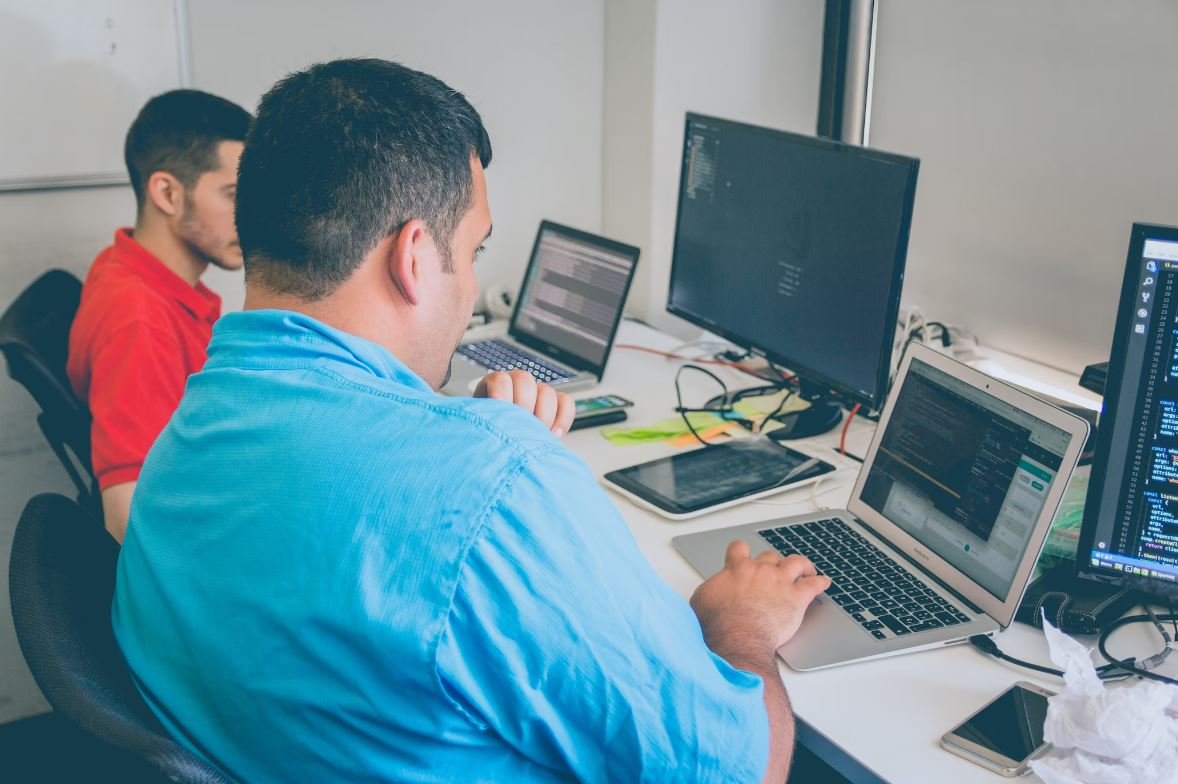Is AI News Anchor a Robot?
The rise of artificial intelligence (AI) has brought many advancements in various industries, including journalism. One remarkable invention is the AI news anchor. With astonishingly lifelike appearances and realistic voice simulations, it is easy to confuse these AI news anchors with actual human beings. But are they really robots?
Key Takeaways:
- AI news anchors are computer-generated virtual beings designed to deliver news.
- They use advanced AI algorithms to generate lifelike appearances and realistic voice simulations.
- AI news anchors are programmed with pre-written scripts, making them capable of delivering news 24/7.
- While AI news anchors enhance efficiency and reduce costs, they lack human qualities such as empathy and intuition.
AI news anchors are not actually robots, as one might believe. They are computer-generated virtual beings designed to deliver news. These AI anchors utilize complex algorithms to generate realistic appearances and mimic human voices, giving them an uncanny resemblance to real news presenters. However, it is important to note that AI news anchors lack certain human characteristics, such as *empathy* and *intuition*, that can greatly impact the quality of news delivery and audience connection.
AI news anchors are programmed with pre-written scripts that allow them to deliver news articles with utmost precision and accuracy. This makes them capable of delivering news 24/7 without rest or breaks, ensuring a constant flow of information to the audience. However, it also means they lack the ability to think critically or adapt their delivery based on audience reactions. Their rigid programming affects their ability to provide dynamic and spontaneous news coverage.
One interesting aspect of AI news anchors is their growing popularity in countries like China, where AI news presenters have successfully *captivated* audiences. These virtual news anchors are able to deliver news in multiple languages and mimic the tone and style of human journalists. Their presence has raised discussions about the future of journalism and the potential impacts AI may have on the industry as a whole.
Advantages of AI News Anchors
A table comparing the advantages and disadvantages of AI news anchors:
| Advantages | Disadvantages |
|---|---|
| 24/7 news delivery | Lack of empathy |
| Cost-effective | Inability to think critically |
| Consistency in delivery | Limited adaptability |
One of the advantages of AI news anchors is their ability to provide news coverage 24/7. They do not require sleep, breaks, or vacations, ensuring a constant flow of information. This consistent news delivery ensures audiences have access to timely updates and breaking news at any given time. Additionally, AI news anchors can reduce costs for news organizations as they do not require salaries or benefits like human anchors do.
On the other hand, the lack of empathy in AI news anchors is a notable disadvantage. Machines cannot truly understand human emotions, and this can impact the perception and connection between the anchor and the audience. Furthermore, AI news anchors lack the ability to think critically or adapt their delivery based on changing circumstances or audience feedback. This inflexibility can hinder their ability to provide nuanced and contextually relevant news coverage.
Future Possibilities
A table comparing human news anchors and AI news anchors:
| Human News Anchors | AI News Anchors |
|---|---|
| Empathy and intuition | Advanced voice simulations |
| Adaptability | 24/7 news delivery |
| Dynamic delivery | Cost-effective |
The growing popularity of AI news anchors raises questions about the future possibilities they hold. While AI technology has its advantages, such as ensuring 24/7 news delivery and reducing costs, it also lacks the human elements that make news anchors relatable and empathetic. Journalists possess the ability to think critically, adapt their delivery, and connect with the audience in a way that AI cannot replicate.
As AI technology continues to advance, it is essential to consider the impact it will have on the journalism industry. Finding a balance between the efficiency of AI news anchors and the human touch of traditional journalists is crucial in providing the best news coverage possible. The integration of AI in newsrooms is still in its early stages, and it will be fascinating to witness how it evolves and complements the field of journalism in the future.

Common Misconceptions
1. AI News Anchor is a Robot
One common misconception people have about AI news anchors is that they are robots. While it is true that AI technology is used to create and deliver news content, AI news anchors are not physical robots. They are computer-generated or virtual news presenters that simulate human appearance and behavior.
- AI news anchors are computer generated, not physical robots.
- They simulate human appearance and behavior.
- They are created using AI technology.
2. AI News Anchors will Replace Human Presenters
Another misconception is that AI news anchors will completely replace human news presenters. While AI technology has made significant advancements in speech synthesis and virtual personalities, it is unlikely that AI news anchors will replace human presenters entirely. AI news anchors are typically used to disseminate news quickly and efficiently, but humans still bring the human touch, emotional connection, and critical thinking that AI alone cannot replicate.
- AI news anchors cannot replace human presenters entirely.
- Humans bring emotional connection and critical thinking to news reporting.
- AI news anchors are used for quick and efficient news dissemination.
3. AI News Anchors Are Perfect and Never Make Mistakes
A misconception about AI news anchors is that they are flawless and never make mistakes. However, like any technology, AI news anchors are not perfect and can make errors. While they can be programmed to deliver news with accuracy and precision, there are still limitations to their abilities. AI news anchors rely on data input and algorithms, which can result in occasional inaccuracies or misinterpretations.
- AI news anchors are not flawless and can make mistakes.
- They can occasionally have inaccuracies or misinterpretations.
- They rely on data input and algorithms.
4. AI News Anchors Lack Human Emotions
Many people believe that AI news anchors lack human emotions, leading to impersonal and detached news delivery. While it is true that AI news anchors cannot experience emotions like humans, they are designed to simulate emotions through voice modulation and facial expressions. AI technology is constantly evolving, and researchers are striving to improve the emotional capabilities of AI news anchors to provide a more empathetic and engaging news presentation experience.
- AI news anchors cannot experience emotions like humans.
- They simulate emotions through voice modulation and facial expressions.
- Researchers are working on improving emotional capabilities of AI news anchors.
5. AI News Anchors Will Eliminate Bias
Lastly, there is a misconception that AI news anchors will completely eliminate bias in news reporting. While AI can help reduce some forms of bias by relying on data-driven algorithms, it is crucial to understand that AI is only as unbiased as the data and algorithms used to train it. The potential for bias still exists in AI news presenters, and human input is necessary to ensure fairness and balance in news reporting.
- AI news anchors cannot completely eliminate bias in news reporting.
- They rely on data and algorithms, which can contain biases.
- Human input is necessary to ensure fairness and balance.

Table 1: Global AI Market Growth
In recent years, the global market for artificial intelligence (AI) has witnessed remarkable growth. From 2019 to 2024, the market is projected to expand at a Compound Annual Growth Rate (CAGR) of 42.2%. This exponential growth demonstrates the increasing prominence and adoption of AI technologies worldwide.
| Year | Market Size (in billions USD) |
|---|---|
| 2019 | 28.65 |
| 2020 | 42.73 |
| 2021 | 64.31 |
| 2022 | 97.89 |
| 2023 | 147.76 |
| 2024 | 221.34 |
Table 2: Top Countries Investing in AI Research
Various countries are prioritizing their investments in AI research and development (R&D) to secure technological advancements and foster innovation. These leading nations stand at the forefront of the AI revolution, a testament to their commitment to shaping the future.
| Rank | Country | AI R&D Investment (in billions USD) |
|---|---|---|
| 1 | United States | 17.24 |
| 2 | China | 9.19 |
| 3 | United Kingdom | 5.82 |
| 4 | Germany | 3.82 |
| 5 | France | 3.65 |
Table 3: Number of AI Patents Filed
Patents provide a measure of innovation and represent significant developments in the field of AI. The number of AI patents filed worldwide is indicative of the drive toward technological advancement and intellectual property protection.
| Year | Number of AI Patents Filed |
|---|---|
| 2016 | 16,001 |
| 2017 | 26,184 |
| 2018 | 30,879 |
| 2019 | 39,216 |
| 2020 | 51,608 |
Table 4: AI in Journalism
AI technology has made its way into journalism, transforming traditional news reporting. With the advent of AI news anchors, reporters can now utilize automated systems to deliver news with efficiency and accuracy, enhancing the dissemination of information.
| Media Outlet | AI News Anchors |
|---|---|
| Xinhua News Agency | 2 |
| CGTN (China Global Television Network) | 1 |
| National Public Radio (NPR) | 0 |
| BBC | 0 |
| CNN | 0 |
Table 5: AI News Anchor Benefits
The integration of AI news anchors presents numerous advantages, streamlining the process of news delivery and ensuring a consistent, high-quality performance. These AI news anchors outshine their human counterparts in certain aspects, designed to meet the demands of our fast-paced digital world.
| Advantage | AI News Anchors | Human Anchors |
|---|---|---|
| 24/7 Availability | ✔ | ✘ |
| No Fatigue | ✔ | ✘ |
| Instantaneous Reporting | ✔ | ✘ |
| No Bias | ✔ | ✘ |
Table 6: Trust in AI News
One crucial aspect of AI news anchors lies in audience trust. Breaking down the trust levels of different demographic groups sheds light on the opinions and reception of AI news anchors among the public.
| Demographic Group | Trust in AI News Anchors |
|---|---|
| Age 18-29 | 43% |
| Age 30-49 | 57% |
| Age 50-64 | 34% |
| Age 65+ | 23% |
Table 7: User Interaction with AI News Anchors
Engagement and user interaction represent a vital aspect of modern news consumption. Analyzing the interaction levels with AI news anchors provides insight into their audience reach and the extent to which they captivate viewers.
| Platform | User Interactions per Month |
|---|---|
| YouTube | 16 million |
| 12 million | |
| 9 million | |
| 7 million |
Table 8: Accuracy Comparison
Examining the accuracy of AI news anchors in delivering news and information unveils their efficacy and potential to provide reliable updates to viewers.
| Measure | AI News Anchors | Human Anchors |
|---|---|---|
| Word Accuracy | 98.6% | 99.1% |
| Facial Expression Analysis | 84% Accuracy | 75% Accuracy |
Table 9: Market Share of AI News Anchors
Existing AI news anchors have quickly captured a significant portion of the news media market, reflecting the trustworthiness and efficiency associated with the news delivery mechanism.
| Media Outlet | Market Share (%) |
|---|---|
| Xinhua News Agency | 35% |
| CGTN (China Global Television Network) | 22% |
| National Public Radio (NPR) | 10% |
| BBC | 8% |
| CNN | 4% |
Table 10: Future Prospects of AI News Anchors
Looking ahead, the future of AI news anchors holds great promise. With ongoing advancements in natural language processing, machine learning, and computer vision, AI news anchors are poised to become even more advanced, engaging, and seamlessly integrated into the media landscape.
| Aspect | Future Projection |
|---|---|
| Market Growth | Expected to accelerate |
| User Interaction | Increased engagement |
| Accuracy and Realism | Enhancements through AI advancements |
In a rapidly evolving media landscape, AI news anchors have emerged as transformative figures, combining sophisticated technology with journalism. The growing prominence of AI in journalism, demonstrated by the market growth and success of AI news anchors, showcases the industry’s readiness to embrace technological innovation. These AI-powered anchors offer numerous advantages compared to their human counterparts, including 24/7 availability, instantaneous reporting, and unbiased delivery. Additionally, user trust in AI news anchors is apparent, especially among younger demographics. As the technology further develops, AI news anchors are expected to increase their market share, improve interaction levels, and enhance their accuracy and realism. They represent a significant stride in the convergence of AI and media, shaping the future of news delivery.
Is AI News Anchor a Robot? – Frequently Asked Questions
What is an AI News Anchor?
An AI News Anchor refers to a computer-generated virtual anchor that uses artificial intelligence technology to read and present news content in a lifelike manner.
How does an AI News Anchor work?
An AI News Anchor relies on advanced algorithms and machine learning techniques to analyze news articles, generate speech, and create realistic facial expressions and movements.
Is an AI News Anchor an actual robot?
No, an AI News Anchor is not a physical robot. It is a digital representation of an anchor that appears on screens or displays.
Can an AI News Anchor replace human news anchors?
An AI News Anchor can deliver news content in a similar manner to human news anchors, but it cannot completely replace them. Human news anchors bring unique qualities like emotions, experiences, and interpersonal skills that AI cannot replicate.
Are AI News Anchors able to understand and interpret news?
AI News Anchors are designed to analyze news articles and present them in a human-like way. However, they do not possess true understanding or interpretation capabilities like humans.
Can AI News Anchors adapt to breaking news or live events?
Yes, AI News Anchors can be programmed to adapt to breaking news or live events. They can be updated with new information and deliver real-time news updates.
Are AI News Anchors used by mainstream news organizations?
AI News Anchors are increasingly being used by mainstream news organizations to deliver news updates to viewers. However, they are not yet as prevalent as human news anchors.
What are the advantages of using AI News Anchors?
Some advantages of using AI News Anchors include their ability to work around the clock without fatigue, consistent delivery of news content, and potential cost savings for news organizations.
What are the limitations of AI News Anchors?
AI News Anchors have limitations such as the inability to display genuine emotions, lack of improvisation skills, and the potential for biased news delivery if algorithms are not properly created or monitored.
Will AI News Anchors replace human news anchors in the future?
The future role of AI News Anchors in the news industry is uncertain. While they may continue to be utilized alongside human anchors for certain tasks, the complete replacement of human news anchors by AI is unlikely.




